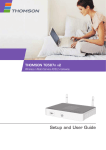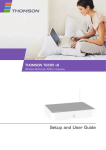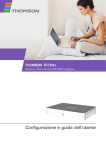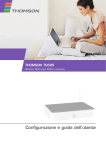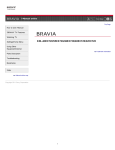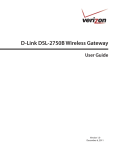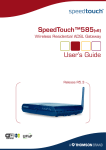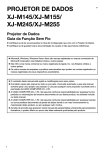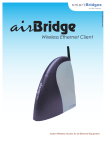Download TG589vn v3
Transcript
Copyright Copyright ©1999-2014 Technicolor. All rights reserved. Distribution and copying of this document, use and communication of its contents is not permitted without written authorization from Technicolor. The content of this document is furnished for informational use only, may be subject to change without notice, and should not be construed as a commitment by Technicolor. Technicolor assumes no responsibility or liability for any errors or inaccuracies that may appear in this document. TECHNICOLOR WORLDWIDE HEADQUARTERS 1, rue Jeanne d’Arc 92443 Issy-les-Moulineaux France http://www.technicolor.com Trademarks The following trademarks may be used in this document: AutoWAN sensing™ is a trademark of Technicolor. Adobe®, the Adobe logo, Acrobat and Acrobat Reader are trademarks or registered trademarks of Adobe Systems, Incorporated, registered in the United States and/or other countries. Apple® and Mac OS® are registered trademarks of Apple Computer, Incorporated, registered in the United States and other countries. Bluetooth® word mark and logos are owned by the Bluetooth SIG, Inc. DECT™ is a trademark of ETSI. DLNA® is a registered trademark, DLNA disc logo is a service mark, and DLNA Certified is a trademark of the Digital Living Network Alliance. Digital Living Network Alliance is a service mark of the Digital Living Network Alliance. Ethernet™ is a trademark of Xerox Corporation. Microsoft®, MS-DOS®, Windows®, Windows NT® and Windows Vista® are either registered trademarks or trademarks of Microsoft Corporation in the United States and/or other countries. UNIX® is a registered trademark of UNIX System Laboratories, Incorporated. UPnP™ is a certification mark of the UPnP™ Implementers Corporation. Wi-Fi®, WMM® and the Wi-Fi logo are registered trademarks of the Wi-Fi Alliance®. Wi-Fi CERTIFIED, Wi-Fi ZONE, Wi-Fi Protected Access, Wi-Fi Multimedia, Wi-Fi Protected Setup, WPA, WPA2 and their respective logos are trademarks of the Wi-Fi Alliance®. Other brands and product names may be trademarks or registered trademarks of their respective holders. All other logos, trademarks and service marks are the property of their respective owners, where marked or not. Document Information Status: v2.0 (February 2014) Reference: DMS-CTC-20130614-0000 Short Title: Setup and User Guide MediaAccess TG589vn v3 R10.5.x Contents 1 Getting Started ......................................................................................................... 2 1.1 Features at a Glance ..................................................................................................................................3 1.2 Components .............................................................................................................................................. 4 1.2.1 1.2.2 1.2.3 1.2.4 1.2.5 Power ............................................................................................................................................................................... 5 Local Network Connection........................................................................................................................................... 6 Broadband Connection ................................................................................................................................................. 7 Buttons............................................................................................................................................................................. 8 Status LEDs .................................................................................................................................................................... 9 1.3 Preparing for the Installation................................................................................................................... 12 2 Installation................................................................................................................13 2.1 Connecting the TG589vn v3 to your Service Provider’s Network.....................................................14 2.2 Powering on the TG589vn v3.................................................................................................................16 2.3 Connecting Your Network Devices to the TG589vn v3 .................................................................... 17 2.3.1 Setting up a Wireless Connection...............................................................................................................................18 2.3.2 Setting up a Wired Connection...................................................................................................................................19 2.4 Setting Up the 3G Fall-Back WAN Connection................................................................................. 20 3 TG589vn v3 GUI..................................................................................................... 22 3.1 Access........................................................................................................................................................23 3.2 Components ............................................................................................................................................ 24 3.3 Protecting Access to the TG589vn v3 ................................................................................................. 26 4 The TG589vn v3 Wireless Access Point .................................................................27 4.1 4.2 4.3 4.4 Connecting Your Wireless Client via WPS ......................................................................................... 28 Connecting Your Wireless Client without WPS ................................................................................. 30 Connecting Your Wireless Client via QR Code.................................................................................. 31 Securing Your Wireless Connection......................................................................................................32 5 Saving Energy ......................................................................................................... 34 5.1 Code of Conduct.....................................................................................................................................35 5.2 ECO Manager......................................................................................................................................... 36 5.3 Manually Switching Off Services to Reduce Power ............................................................................37 6 Sharing Content...................................................................................................... 38 6.1 The Network File Server ........................................................................................................................40 6.2 The UPnP AV Media Server ................................................................................................................. 43 6.2.1 Configuring the UPnP AV Media Server .................................................................................................................44 6.2.2 Using the UPnP AV Media Server ............................................................................................................................ 45 6.3 The FTP Server ....................................................................................................................................... 47 6.4 Managing your Shared Content............................................................................................................ 49 6.5 Safely Removing your USB Storage Device.........................................................................................51 7 Network Services..................................................................................................... 52 DMS-CTC-20130614-0000 v2.0 i Contents 7.1 UPnP..........................................................................................................................................................53 7.1.1 7.1.2 7.1.3 7.1.4 Accessing Your TG589vn v3 via UPnP..................................................................................................................... 54 Managing your Internet connection via UPnP ......................................................................................................... 55 Configuring UPnP on the TG589vn v3..................................................................................................................... 57 Installing UPnP on Windows XP ................................................................................................................................ 58 7.2 Assigning a service (HTTP, FTP,...) to a Computer..........................................................................60 7.3 Dynamic DNS ......................................................................................................................................... 62 7.4 Network Time Server.............................................................................................................................. 63 8 Internet Security...................................................................................................... 64 8.1 Parental Control ...................................................................................................................................... 65 8.2 Firewall...................................................................................................................................................... 67 9 Support.................................................................................................................... 69 9.1 9.2 9.3 9.4 9.5 General TG589vn v3 Troubleshooting ................................................................................................ 70 Wired Connection Troubleshooting ..................................................................................................... 71 Wireless Connection Troubleshooting..................................................................................................72 Content Sharing Troubleshooting .........................................................................................................73 Reset to Factory Defaults ...................................................................................................................... 74 DMS-CTC-20130614-0000 v2.0 ii About this Setup and User Guide About this Setup and User Guide In this Setup and User Guide The goal of this Setup and User Guide is to show you: Set up your TG589vn v3 and local network Configure and use the main features of your TG589vn v3. Used Symbols The danger symbol indicates that there may be a possibility of physical injury. The warning symbol indicates that there may be a possibility of equipment damage. The caution symbol indicates that there may be a possibility of service interruption. The note symbol indicates that the text provides additional information about a topic. Typographical Conventions Following typographical convention is used throughout this manual: This sample text indicates a hyperlink to a Web site. Example: For more information, visit us at www.technicolor.com. This sample text indicates an internal link. Example: If you want to know more about guide, see “About this Setup and User Guide” on page 1. This sample text indicates an important content-related word. Example: To enter the network, you must authenticate yourself. This sample text indicates a GUI element (commands on menus and buttons, dialog box elements, file names, paths and folders). Example: On the File menu, click Open to open a file. DMS-CTC-20130614-0000 v2.0 1 1 Getting Started 1 Getting Started Introduction This chapter gives you a brief overview of the main features and components of the TG589vn v3. After this chapter we will start with the installation. Do not connect any cables to the TG589vn v3 until instructed to do so. DMS-CTC-20130614-0000 v2.0 2 1 Getting Started 1.1 Features at a Glance Introduction This section provides a brief overview of the main features of your TG589vn v3. IPv6 Ready Your TG589vn v3 is IPv6 ready. Internet Protocol version 6 (IPv6) is the next generation of Internet technologies aiming to effectively support the ever-expanding Internet usage and functionality, and also to address security concerns that exist in an IPv4 environment. Internet connection features Broadband Internet access via the integrated DSL modem. The first chapters describe how to connect your TG589vn v3 to the Internet. 3G (Fall-back) High-speed Internet Access via the optional mobile USB adaptor. For more information, see “2.4 Setting Up the 3G Fall-Back WAN Connection” on page 20. Internet Security for your entire network. For more information, see “8 Internet Security” on page 64. Useful network tools like UPnP, Dynamic DNS and many more. For more information, see “7 Network Services” on page 52. Local networking features Wired access for your local network devices via the Ethernet interface. For more information, see “2.3 Connecting Your Network Devices to the TG589vn v3” on page 17. Wireless access for your local network devices via the integrated IEEE 802.11n wireless access point. For more information, see “4 The TG589vn v3 Wireless Access Point” on page 27. An Integrated Media Server allowing you to share your media with media players and other network devices. For more information, see “6 Sharing Content” on page 38. ECO label Technicolor’s ECO label guarantees you that the TG589vn v3 is able to reduce its power consumption to an absolute minimum. For more information, see “5 Saving Energy” on page 34. TG589vn v3 configuration tools The TG589vn v3 GUI allows you to configure your TG589vn v3 via your web browser. For more information, see “3 TG589vn v3 GUI” on page 22. DMS-CTC-20130614-0000 v2.0 3 1 Getting Started 1.2 Components Overview This section provides an overview of the different components of the TG589vn v3: Topic Page 1.2.1 Power 5 1.2.2 Local Network Connection 6 1.2.3 Broadband Connection 7 1.2.4 Buttons 8 1.2.5 Status LEDs 9 DMS-CTC-20130614-0000 v2.0 4 1 Getting Started 1.2.1 Power Overview Power inlet The power inlet ( ) allows you to connect the power supply. Only use the power supply delivered with your TG589vn v3. Power switch The power switch ( DMS-CTC-20130614-0000 v2.0 ) allows you to power on/off your TG589vn v3. 5 1 Getting Started 1.2.2 Local Network Connection Overview Wireless Access Point The built-in WiFi-certified wireless access point provides wireless access to your WiFi-certified wireless clients. For more information, see “4 The TG589vn v3 Wireless Access Point” on page 27. Ethernet switch The Ethernet switch ( ) allows you to connect an Ethernet device (for example, a computer) to your local network. For more information, see “2.3 Connecting Your Network Devices to the TG589vn v3” on page 17. A LED may be provided per Ethernet port to indicate link integrity (or activity). LED Status Description Solid on Device connected. Blinking Device connected and sending/receiving data. Off No device connected. USB Port The USB port ( ) can be used to: Connect a USB mass storage device to share your content (for example, music, movies,...): On your local network via the Network File server or the UPnP AV Media Server. On Internet via FTP. For more information, see “6 Sharing Content” on page 38. Connect a 3G mobile adaptor to set up a 3G connection that can work as a backup for your main Internet connection. For more information, see “2.4 Setting Up the 3G Fall-Back WAN Connection” on page 20. DMS-CTC-20130614-0000 v2.0 6 1 Getting Started 1.2.3 Broadband Connection Overview DSL DSL port This port can be used to connect your TG589vn v3 to your service provider’s DSL network. For more information, see “2.1 Connecting the TG589vn v3 to your Service Provider’s Network” on page 14. DMS-CTC-20130614-0000 v2.0 7 1 Getting Started 1.2.4 Buttons Overview Reset WPS button The WPS ( ) button allows you to add new wireless clients to your network in a swift and easy way, without the need to enter any of your wireless settings manually. For more information, see “4.1 Connecting Your Wireless Client via WPS” on page 28. ECO button The ECO ( ) button allows you to disable your wireless access point. You can do this when you do not have any devices that are connected to the wireless access point. This allows you to save the energy that the TG589vn v3 would be using for the wireless access point. For more information, see “ECO button” on page 37. Reset button The Reset button allows you to reset your TG589vn v3 to factory defaults. For more information, see “9.5 Reset to Factory Defaults” on page 74. DMS-CTC-20130614-0000 v2.0 8 1 Getting Started 1.2.5 Status LEDs Introduction On the front panel of your TG589vn v3, you can find a number of status LEDs, indicating the state of the device. Power Ethernet USB Wireless Broadband Internet Upgrade WPS Power LED Colour State Description Green Solid on Power on, normal operation Blinking Bootloader active (during upgrade) Red Solid on Power on, self-test failed, indicating device malfunction Orange Solid on Bootloader selftest Blinking Bootloader active (during upgrade) Off The TG589vn v3 is powered off. Ethernet LED Colour State Description Green Solid on Network device connected to the Ethernet switch. Blinking Network device connected to the Ethernet switch and sending/receiving data. Off DMS-CTC-20130614-0000 v2.0 No Ethernet connection on your local network 9 1 Getting Started USB LED Colour State Description Green Solid on Device(s) connected to the TG589vn v3’s USB port Off No device connected to the TG589vn v3’s USB port Wireless LED Colour State Description Green Solid on No wireless activity, WPA2-PSK or WPA-PSK encryption Blinking Wireless activity, WPA2-PSK or WPA-PSK encryption Solid on No wireless activity, WEP encryption Blinking Wireless activity, WEP encryption Solid on No wireless activity, no security Blinking Wireless activity, no security Toggling Wireless client registration phase Orange Red Red/green Off Wireless access point disabled Broadband LED Colour State Description Green Solid on DSL line synchronised Blinking Trying to detect carrier signal or pending DSL line synchronisation Off TG589vn v3 powered off. Internet LED Colour State Description Green Solid on Connected to the Internet, no activity Blinking Connected to the Internet, sending/receiving data Solid on Failed to setup the Internet connection Red Off No Internet connection Upgrade LED Colour State Description Blue Solid on Software upgrade ongoing Off No software upgrade ongoing Do not power off your TG589vn v3 or disconnect any cables as long as the Upgrade LED is on. Interrupting the upgrade procedure may damage your TG589vn v3. DMS-CTC-20130614-0000 v2.0 10 1 Getting Started WPS LED Colour State Description Green Solid On Client successfully registered via WPS Orange Blinking WPS registration ongoing Red Blinking Error occurred For more information about WPS, see “4.1 Connecting Your Wireless Client via WPS” on page 28. DMS-CTC-20130614-0000 v2.0 11 1 Getting Started 1.3 Preparing for the Installation DSL service requirements Make sure that: Your service provider activated the DSL service on your telephone line by your service provider. You have the installation information (for example, user name, password, service profile,...) provided by your service provider at hand. Local connection requirements Wireless connection If you want to connect your computer using a wireless connection, your computer must be equipped with a WiFi-certified wireless client adapter. Wired connection If you want to connect a computer using a wired connection, your computer must be equipped with an Ethernet Network Interface Card (NIC). Start with the installation You are now ready to start with the installation of your TG589vn v3. DMS-CTC-20130614-0000 v2.0 12 2 Installation 2 Installation Introduction This chapter will help you to install your TG589vn v3. Setting up your network Proceed as follows: 1 Connect your TG589vn v3 to your service provider’s network. For more information, see “2.1 Connecting the TG589vn v3 to your Service Provider’s Network” on page 14. 2 Power on the TG589vn v3. For more information, see “2.2 Powering on the TG589vn v3” on page 16. 3 Connect your computer to the TG589vn v3. For more information, see “2.3 Connecting Your Network Devices to the TG589vn v3” on page 17. 4 Share your content or media on your local network, continue with “6 Sharing Content” on page 38. 5 If you purchased the mobile USB adapter, setup the 3G backup connection. For more information, see “2.4 Setting Up the 3G Fall-Back WAN Connection” on page 20. DMS-CTC-20130614-0000 v2.0 13 2 Installation 2.1 Connecting the TG589vn v3 to your Service Provider’s Network Introduction This section helps you to connect the TG589vn v3 to your service provider’s network. Signal arriving at your home The Line signal that arrives at your home consists the following components: A Phone signal carrying the traffic for telephony. This Phone signal is only used for communication over the traditional telephone network (PSTN). Voice over IP communication will be carried by the DSL signal. A DSL signal carrying the Internet traffic. DSL Gateways have a built-in solution to remove the Phone component. No additional devices are needed, you can connect them directly to the Line. Telephones do not have this capability, so here you have to use a filter or splitter to remove the DSL signal. What does a filter/splitter look like A splitter/filter is a box that typically has the following connectors: PHONE Service Provider Voice LINE DSL + Voice MODEM DSL + Voice Filter/Splitter A Line input This connector must be connected to the input signal that needs to be filtered. A Phone/PSTN output This connector offers filtered output signal. It only contains the Voice component and can only be used for connecting phones. A Modem/DSL output (optional) This connector offers unfiltered output. It contains both the Phone and DSL signal and can be used to connect your TG589vn v3. DMS-CTC-20130614-0000 v2.0 14 2 Installation Connecting the cables Proceed as follows: 1 Take the DSL cable. This is the grey cable that is included in your box. 2 Plug one end of the cable in the grey DSL port on the back of your TG589vn v3. DSL 3 Plug the other end of the cable into the DSL/MODEM output port of your filter/splitter. DMS-CTC-20130614-0000 v2.0 15 2 Installation 2.2 Powering on the TG589vn v3 Procedure Proceed as follows: 1 Connect the power cord to the power port of the TG589vn v3. 2 Plug the other end of the power cord into an electrical outlet. 3 Press the power button to turn on the TG589vn v3. 4 Wait at least two minutes to allow the TG589vn v3 to complete the start up phase. DMS-CTC-20130614-0000 v2.0 16 2 Installation 2.3 Connecting Your Network Devices to the TG589vn v3 Choose your connection method To connect your device via: A wireless connection, continue with “2.3.1 Setting up a Wireless Connection” on page 18. A wired connection, continue with “2.3.2 Setting up a Wired Connection” on page 19. DMS-CTC-20130614-0000 v2.0 17 2 Installation 2.3.1 Setting up a Wireless Connection The TG589vn v3 access point Your TG589vn v3 is equipped with a wireless access point that supports the following standards: IEEE 802.11n IEEE 802.11g IEEE 802.11b Requirements Your network device must be equipped with a WiFi-certified wireless client. Connection speed When setting up your wireless network, keep in mind that the following factors may have a negative impact on your wireless connection speed: The obstacles (walls, ceilings,...) between the wireless client and the access point. Distance between the wireless client and the access point. To fully benefit from the improved connection speed offered by the IEEE 802.11n standard, it is recommended to only connect IEEE 802.11n wireless clients to your TG589vn v3. Connecting older (for example, IEEE 802.11g) wireless clients may also slow down connection speed of the IEEE 802.11n capable clients. If you have problems with your wireless performance, see “Poor Wireless Connectivity or Range” on page 72. To set up a wireless connections For more information on how to setup a wireless connection between your network device and your TG589vn v3, see “4 The TG589vn v3 Wireless Access Point” on page 27. DMS-CTC-20130614-0000 v2.0 18 2 Installation 2.3.2 Setting up a Wired Connection Requirements Both your network device (for example, a computer, a gaming console,...) and TG589vn v3 must have a free Ethernet port. Your network device must be configured to obtain an IP address automatically. This is the default setting. Ethernet cable In your package, you will find a cable with yellow connectors. This is the Ethernet cable. Procedure Proceed as follows: 1 Connect one end of the Ethernet cable to one of the yellow Ethernet ports of your TG589vn v3: 2 Connect the other end of the Ethernet cable to your network device. The TG589vn v3 does not support Power over Ethernet (PoE). All network devices that are connected to the TG589vn v3 must be powered by their own power source. 3 Your network device is now connected to your network. No additional configuration is needed unless specified by your service provider. DMS-CTC-20130614-0000 v2.0 19 2 Installation 2.4 Setting Up the 3G Fall-Back WAN Connection Introduction Many SOHO (Small Offices, Home Offices) and SME (Small/Medium Enterprises) businesses choose DSL as their access technology for a Wide Area Network (WAN) connection because this is typically cheaper than using leased lines. A dropout of a DSL line can however have expensive consequences due to inaccessibility of the Internet and E-mail. Therefore backup solutions are available that provide an alternative path when the DSL line is down. For example it is possible to switch to 2G / 3G mobile access technologies such as GPRS, UMTS, HSDPA, HSUPA, HSPA+, WIMAX and LTE when internet connectivity is not available via the main WAN connection. By plugging a mobile USB adapter into one of the USB ports of your TG589vn v3, IP connectivity via a 2G / 3G network becomes possible. 3G is an umbrella-term to indicate the third generation mobile telephony technology. The services associated with 3G provide the ability to transfer both voice data and non-voice data. 3G networks are the successors of the 2G networks, such as the GSM networks and provide new services and higher data transfer speeds. What do I need? To start using 2G / 3G as a connection on the TG589vn v3, you need: A mobile USB adapter Only use the mobile USB adapters provided by your service provider. A registered Security Identity Module (SIM) card. Procedure Proceed as follows: 1 Power off the TG589vn v3. If you do not power off the TG589vn v3 first, the mobile USB adapter will not be detected. 2 Insert your SIM card into the mobile USB adapter. 3 Plug the mobile USB adapter in (one of) the USB port(s) of your TG589vn v3: 4 Power on the TG589vn v3. 5 Now your mobile connection is up and ready to use. If you need to remove your mobile USB adapter, make sure the TG589vn v3 is powered off first. Result TG589vn v3 will automatically enable your 3G backup connection when both of the following conditions are met: DMS-CTC-20130614-0000 v2.0 20 2 Installation The main Internet connection has been unavailable for at least 60 seconds. The TG589vn v3 received a request to access the Internet (for example, when browsing to an Internet web site). The TG589vn v3 will automatically disable the 3G connection in either of the following cases: The main Internet connection is available again. In this case the TG589vn v3 switches back to the main Internet connection. No Internet traffic has been detected during the last 10 seconds. For example, you finished surfing the Internet. DMS-CTC-20130614-0000 v2.0 21 3 TG589vn v3 GUI 3 TG589vn v3 GUI Introduction The TG589vn v3 Graphical User Interface (GUI) allows you to configure your TG589vn v3 using your web browser. Requirements JavaScript must be enabled on your browser (this is the default setting). For more information, consult the help of your web browser. DMS-CTC-20130614-0000 v2.0 22 3 TG589vn v3 GUI 3.1 Access Accessing the TG589vn v3 GUI Proceed as follows: 1 Open your web browser. 2 Browse to http://myrouter.home or to the IP address of your TG589vn v3 (by default: 192.168.1.1). 3 If you have protected your TG589vn v3 with a user name and password, the TG589vn v3 will prompt you to enter these. Enter your user name (default: admin) and password (default: admin) and click OK. For more information, see “3.3 Protecting Access to the TG589vn v3” on page 26. 4 The TG589vn v3 GUI appears. Access the TG589vn v3 via UPnP You can also access the TG589vn v3 GUI using the Internet Gateway Device (IGD) icon if your computer runs one of the following operating systems: Microsoft Windows 7 Microsoft Windows Vista Microsoft Windows XP For more information, see “7.1 UPnP” on page 53. DMS-CTC-20130614-0000 v2.0 23 3 TG589vn v3 GUI 3.2 Components Overview Depending on your user right and location on the GUI, the following components can be available: 2 3 4 5 1 6 Label Description 1 Menu 2 Login section 3 Notification area 4 Navigation bar 5 Content pane 6 Tasks pane Menu The menu consists of the following menu items: Home: Allows you to go back to the TG589vn v3 home page. TG589vn v3: Provides basic information on the TG589vn v3. Broadband Connection: Allows you to view/configure your broadband connections. Toolbox: Allows you to configure the network services and security settings of your TG589vn v3. Home Network: Allows you to manage your local network. Help: Allows you to view context-related help information. Each of these items contain a number of sub-menu items. DMS-CTC-20130614-0000 v2.0 24 3 TG589vn v3 GUI Login section In the login section you can see the current user name. By clicking the user name, you can: Change your password. Switch to another user. Notification area The notification area displays: Error messages, indicated by a red traffic light. Warning messages, indicated by an orange traffic light. Information messages, indicated by a green traffic light. If none of these events occur, the notification is not shown. Navigation bar The Navigation bar displays your current position in the TG589vn v3 GUI. Some page are available in different configuration levels. These pages have additional links (for example, Overview, Configure) in the right part of the navigation bar that allow you to switch between the configuration levels. Content pane The content pane displays the information and configurable items of the selected item. Tasks pane To allow a quick configuration of your TG589vn v3, some pages may offer you a number of related tasks in the Pick a task list. These tasks will guide you to the page where you can perform the selected task. DMS-CTC-20130614-0000 v2.0 25 3 TG589vn v3 GUI 3.3 Protecting Access to the TG589vn v3 Introduction To prevent that every user on your local network can access the TG589vn v3, the TG589vn v3 is secured with a user name and password. Default user name The default user name is admin. Default password The default password is admin. It is recommended to change the default password settings. Choose a password that your can easily remember or write it down. If you forget your password the only option is to reset your TG589vn v3. For more information, see “9.5 Reset to Factory Defaults” on page 74. Protected items The following items are protected by this user name and password: The TG589vn v3 GUI. The embedded FTP Server. for more information, see “6.3 The FTP Server” on page 47. How to change your password Proceed as follows: 1 On the Toolbox menu, click User Management. 2 In the Pick a task list, click Change my password. 3 Enter your new password and click Change Password. 4 Your new password is now active. The next time that you log on to the TG589vn v3 GUI you will have to enter this password. This password will also be used by the network file server and FTP server. For more information about the network file server and FTP server, see “6 Sharing Content” on page 38 DMS-CTC-20130614-0000 v2.0 26 4 The TG589vn v3 Wireless Access Point 4 The TG589vn v3 Wireless Access Point Introduction This section will help you set up your wireless network. What you need to set up a wireless network To set up a wireless network, you need the following components: A Wireless Access Point (already integrated into your TG589vn v3) A Wireless client the device that you want to connect (for example, a computer, smartphone, network printer,...) Wireless Access Point The wireless access point is the heart of your wireless network. The wireless access point: Connects different wireless devices. Secures the data sent over wireless connection. The TG589vn v3 comes with an integrated wireless access point. Wireless client The wireless client allows you to connect a device, typically a computer, to a wireless access point. Both built-in and external (for example via USB) clients are available. Devices like media players and smartphones may also have a built-in wireless client. Check the documentation of your device for more information. Check the documentation of your computer if you are not sure if your computer is equipped with a wireless client. Configuring your wireless clients For more information on how to establish a wireless connection to the TG589vn v3, see: “4.1 Connecting Your Wireless Client via WPS” on page 28 “4.2 Connecting Your Wireless Client without WPS” on page 30 “4.3 Connecting Your Wireless Client via QR Code” on page 31 Secure your wireless connection! When using an unsecured connection, everyone who is within the range of your TG589vn v3 can access your network. If not: People may use your connection to access the Internet. Hackers may use your connection to commit computer crimes. You can easily prevent this by securing your wireless access point. For more information, see “4.4 Securing Your Wireless Connection” on page 32. DMS-CTC-20130614-0000 v2.0 27 4 The TG589vn v3 Wireless Access Point 4.1 Connecting Your Wireless Client via WPS WPS Wi-Fi Protected Setup (WPS) allows you to add new wireless clients to your local network in a swift and easy way, without the need to enter any of your wireless settings (network name, wireless key, encryption type). Requirements Your wireless client must support WPS. Check the documentation of your wireless client for this. Both Windows 7 and Windows Vista Service Pack 1 have native WPS support. Your TG589vn v3 must use WPA(2)-PSK encryption (default encryption) or no encryption. WPS with WEP encryption is not possible. WPS Methods The following WPS methods are supported by your TG589vn v3: Push Button Configuration (PBC): You have to put both your Wireless USB Adaptor and access point in registration mode. PIN code entry: You have to enter a PIN code on the Wireless Configuration Utility. Procedure for PBC Proceed as follows: 1 Shortly press the WPS button on the TG589vn v3: 2 The WPS button LED starts blinking orange. This indicates that the TG589vn v3 is now searching for wireless clients that are in registration mode. You now have two minutes to start WPS on your wireless client. 3 Start WPS on your wireless client. 4 The TG589vn v3 is now exchanging the security settings. 5 At the end of the procedure the status of the WPS LED will change to either of the following: Solid green This indicates that you have successfully registered your wireless client. You are now connected to the TG589vn v3 network. Blinking red This indicates that the TG589vn v3 could not find your wireless client. Use the same procedure to try again (you do not need to wait until the LED turns off). DMS-CTC-20130614-0000 v2.0 28 4 The TG589vn v3 Wireless Access Point Procedure for PIN code entry Proceed as follows: 1 Check the label on your TG589vn v3 and write down the following information: The PIN code that is printed next to the WPS logo. 1234-5678 The Network Name. This is the default network name (SSID). If you already configured a new network name, write down the new one. 2 Go the WPS PIN code page of your wireless client. 3 Enter the PIN code, Do not include the hyphen when entering the PIN code. For example, if your PIN code is 1234-5678, then enter 12345678. 4 Your wireless client may prompt you to select your access point. If this is the case, select the access point with the network name that you wrote down. Troubleshooting If you are having trouble connecting your wireless client via WPS, this may be cause by one of the following reasons: WPS can not be correctly executed: Configure your wireless manually. For more information, see “4.2 Connecting Your Wireless Client without WPS” on page 30. Your wireless client is out of range: If possible move your wireless client closer to your TG589vn v3 or use a wireless repeater to extend the range of your wireless network. Another device is interfering on the selected wireless channel: Change the wireless channel of your TG589vn v3. For more information, see “Change the wireless channel” on page 72. DMS-CTC-20130614-0000 v2.0 29 4 The TG589vn v3 Wireless Access Point 4.2 Connecting Your Wireless Client without WPS Before you start Before you can connect a wireless client (for example, a computer) to your wireless network you need to know the wireless settings that are currently used by the TG589vn v3, i.e.: The Network Name (SSID) The wireless key What Network Name (SSID) is my TG589vn v3 using? If you did not change the SSID, your TG589vn v3 uses the Network Name that is printed on the back panel label of your TG589vn v3. What wireless key is my TG589vn v3 using? If you did not change the security settings, no wireless key is used. If your service provider did choose to use a default wireless key, use the Wireless Key that is printed on the bottom panel label of your TG589vn v3. Forgot your wireless key? If you have changed the wireless settings manually and you can’t remember your settings, try one of the following: 1 Use a computer that is already connected to your network. If none of your computers is connected yet, connect one with an Ethernet cable. For more information, see “2.3.2 Setting up a Wired Connection” on page 19. 2 Browse to the TG589vn v3 GUI. For more information, see “Accessing the TG589vn v3 GUI” on page 23. 3 Under Home Network menu, click Wireless. 4 In the upper-right corner, click Details. 5 Under: Configuration, you can find the network name (SSID). Security, you can find the encryption. Connecting your wireless client Configure your wireless client with the same wireless settings as your TG589vn v3 (network name and wireless key). For more information, consult the documentation of your wireless client. DMS-CTC-20130614-0000 v2.0 30 4 The TG589vn v3 Wireless Access Point 4.3 Connecting Your Wireless Client via QR Code Introduction The TG589vn v3 allows you to generate a Quick Response (QR) code that contains all wireless settings that are needed to connect. You are then able to connect to the wireless network by scanning the generated code. Target devices This connection method is typically used for tablet computers and smartphones. Requirements Your wireless device must have: A camera to scan the code. An application (app) to interpret the QR code and connect to a wireless network. For example: if you are using Android on your device, you could download Bar Code Scanner from Google Play. Procedure Proceed as follows: 1 Browse to the TG589vn v3 GUI. For more information, see “Accessing the TG589vn v3 GUI” on page 23. 2 Under Home Network, click Wireless. 3 Under Pick a Task, click Generate QR code image. 4 The wireless QR code appears. You can now: Scan the code directly from your screen. Print this page and scan the code from the paper version. 5 Your QR code app shows you the wireless settings used by your TG589vn v3 and offers you to connect to its wireless network. Connect to the network. DMS-CTC-20130614-0000 v2.0 31 4 The TG589vn v3 Wireless Access Point 4.4 Securing Your Wireless Connection Introduction You can protect the wireless communication between the wireless clients and your TG589vn v3 with a wireless key. This means that: Only clients which use the correct Network Name (SSID) and wireless key can connect to your network. All data passing through your wireless access point is secured and encrypted. Encryption types Over the years a number of encryption types have been developed. The list below gives you an overview of the supported encryption types ordered by descending security level; you will find the highest level of security at the top of the list: WPA-PSK Encryption: The wireless connection is secured with a pre-shared key that has been defined by the user. Wireless clients must be configured with this key before they can connect to the TG589vn v3. The TG589vn v3 supports the following WPA-PSK versions (ordered by descending security): WPA2-PSK: The most recent and most secure version of WPA-PSK. Choose this version if you are sure that all your wireless clients support WPA2-PSK. WPA-PSK + WPA2-PSK: This is a mixed mode. In this mode WPA2-PSK, is the preferred encryption type but wireless clients do not support WPA2-PSK, can still use WPA-PSK as encryption type. Choose this option if not all of your wireless clients support WPA2-PSK or if you are not sure. Wireless clients that support WPA2-PSK will use WPA2-PSK, the others will use WPA-PSK. WPA-PSK: The first version of WPA-PSK. Choose this option if you are sure that none of your wireless clients support WPA2-PSK. If you want to configure WPA2-PSK on the built-in wireless utility of Windows XP Service Pack 2 (SP2), you first have to: Upgrade your Windows XP to Service Pack 3. - or Install the following update: http://support.microsoft.com/kb/917021. WEP Encryption: The least safe encryption type used for wireless connections. Like WPA-PSK it uses a user-defined key, but WEP has been proven to have security issues. Although the TG589vn v3 allows you to use WEP or no security, we strongly advise against using one of them! Use WPA(2)-PSK instead. Configuration Proceed as follows: 1 Browse to the TG589vn v3 GUI. For more information, see “Accessing the TG589vn v3 GUI” on page 23. 2 Under Home Network, click Wireless. 3 The Wireless Access Point page appears. In the upper-right corner, click Configure. 4 In the Security Mode list, select one of the following modes: WPA-PSK WPA2-PSK DMS-CTC-20130614-0000 v2.0 32 4 The TG589vn v3 Wireless Access Point WPA-PSK + WPA2-PSK For more information, see “Encryption types” on page 32. 5 In the WPA-PSK Encryption Key box, type a the key of your choice. The key must be in one of the following formats: 8 to 63 alphanumeric characters. For example: MyKey123 8 to 64 hexadecimal characters (characters from 0 to 9 and from A to F). For example: C54F48A5. 6 Click Apply. 7 Reconnect your wireless client(s) to the TG589vn v3 using these new security settings. For more information, see “4.1 Connecting Your Wireless Client via WPS” on page 28 or “4.2 Connecting Your Wireless Client without WPS” on page 30. DMS-CTC-20130614-0000 v2.0 33 5 Saving Energy 5 Saving Energy Code of Conduct To prove its commitment to protect the environment, Technicolor has signed the Code of Conduct, a global agreement to reduce the power consumption of broadband access devices. For more information, see “5.1 Code of Conduct” on page 35. Technicolor power saving innovations To further reduce the power consumption, Technicolor has developed the ECO Manager. This system constantly monitors the services provided by the TG589vn v3 and automatically switches unused services to an ECO-friendly state. For more information, see “5.2 ECO Manager” on page 36. Next to this automated tool, you can also choose to manually disable services that you will not be using. For more information, “5.3 Manually Switching Off Services to Reduce Power” on page 37. DMS-CTC-20130614-0000 v2.0 34 5 Saving Energy 5.1 Code of Conduct Power states Code of Conduct provides rules for the power consumption in: Full power state: This is the normal operation mode of the device, where all functionality is enabled. Low power state: When there is no user traffic on the device, the device should switch to low power mode. This is a state in which devices are only allowed to use a limited amount of energy to be able to power its components and respond to user activity. Example Take the following example: The user switches off his computer at 20:00. There are no other devices connected to the TG589vn v3. The TG589vn v3 switches to low power mode. This results in a considerable drop in the overall power consumption of the TG589vn v3. Power Consumption Full power limit User traffic Low power limit No user traffic 20:00 DMS-CTC-20130614-0000 v2.0 Time 35 5 Saving Energy 5.2 ECO Manager Introduction The TG589vn v3 constantly monitors the user activity and uses this information to optimise the power consumption: For example: The TG589vn v3 reduces the clock frequency of the central processor when there is no or low user activity. This lowered clock frequency will result in a lower power consumption of the TG589vn v3. Disable the USB port(s) when they are not used Switch the wireless interface to power reduction mode. Wireless access point power reduction mode When the TG589vn v3 access point switches to power reduction mode, the access point is switched off and is only power on periodically to be able to detect new clients. If new clients are detected the wireless access point is fully powered again. This is only possible if there are no devices connected to the TG589vn v3. Power reduction is enabled by default, but it is possible to disable it via the TG589vn v3 GUI. To configure power reduction: 1 Browse to the TG589vn v3 GUI. For more information, see “Accessing the TG589vn v3 GUI” on page 23. 2 Under Home Network, click Wireless. 3 In the Navigation bar, click Configure. 4 Under Configuration: Select Power Reduction Enabled to enable power reduction. Clear Power Reduction Enabled to disable power reduction. 5 Click Apply. Example If we use the same example as in the previous section, you can see that the TG589vn v3 is now able to further reduce the power consumption in periods where less action is required from the TG589vn v3. Power Consumption Full power limit Low power limit User Traffic No User Traffic 20:00 DMS-CTC-20130614-0000 v2.0 Time 36 5 Saving Energy 5.3 Manually Switching Off Services to Reduce Power ECO button If you are not using the wireless access point of your TG589vn v3, you might consider to disable the wireless access point permanently. This allows you to further reduce the power consumption. To turn the wireless interface: Off, press the ECO ( ) button until the Wireless LED is off. On, press the ECO ( ) button until the Wireless LED is on. Zero power consumption If you will not be using your TG589vn v3 for a longer time (for example: you are going on holiday), you should consider to turn off the TG589vn v3. This way no energy will be consumed at all. However, be aware that if you turn off the TG589vn v3, all services provided by the TG589vn v3 that require access to the Internet will not be available. For example, you will not be able to browse to Internet websites, listen to radio streams etc. DMS-CTC-20130614-0000 v2.0 37 6 Sharing Content 6 Sharing Content Introduction The TG589vn v3 allows you to share the content stored on your USB storage device with other users on your network or even access this shared content from the Internet. Features The TG589vn v3 supports USB 2.0 The following file systems are supported: NTFS (optional) FAT32 FAT16 HFS+ (optional) EXT2/EXT3 (optional) You can connect up to five USB storage devices (via a USB hub). Each USB storage device can have up to 10 partitions. If your device has more partitions the extra partitions will be ignored. Content Sharing Servers The TG589vn v3 offers three types of services to share your content. The following table gives a you a brief overview of the main functions: Network File Server UPnP AV Media Server FTP Server Function Store and access your data on your local network. Make media files available for UPnP AV capable devices like Media players, Set-Top boxes from your local network. Store and access your data from the Internet. Access Read and write Read-only Read and write Accessible from Local network Local network Internet and Local network Type of content shared All files from all partitions and disks that are connected. Media files (music, movies and pictures) from all partitions and disks that are connected. All files that are stored in the Shared folder of the managed partition. For more information, see... “6.1 The Network File Server” on page 40 “6.2 The UPnP AV Media Server” on page 43 “6.3 The FTP Server” on page 47 DMS-CTC-20130614-0000 v2.0 38 6 Sharing Content Configuration All servers are enabled by default. The only thing that you need to do is to plug your USB memory stick or external hard disk in (one of) the USB port(s) of your TG589vn v3. By using a USB hub, you can connect up to five USB mass storage devices to the TG589vn v3. Do not remove your USB storage device without stopping it first, otherwise data might be lost! For more information, see “6.5 Safely Removing your USB Storage Device” on page 51. DMS-CTC-20130614-0000 v2.0 39 6 Sharing Content 6.1 The Network File Server Introduction The Network Server allows you to share the content on your USB storage device(s) with other devices that are connected to your local network (mostly computers). These devices have read and write access to this USB device(s). Configuration The Network File Server is enabled by default and ready for use. To change the default settings, proceed as follows: 1 Browse to the TG589vn v3 GUI. For more information, see “Accessing the TG589vn v3 GUI” on page 23. 2 On the Toolbox menu, click Content Sharing. 3 In the Navigation bar, click Configure. 4 Under Network File Server (Windows Networking), you can change the following settings: Server Name: Enter the name that you want to use to access the TG589vn v3. Server Description: Add a short description for what kind of data is stored on the USB storage device. Workgroup: Enter the same workgroup as used by your computer(s). Server Enabled: Select this option to enable the Network File Server 5 Click Apply. 6 All users connected to the TG589vn v3 can now access the data stored on your USB storage device. 7 If you want to limit the number of folders that can be accessed, continue with “6.4 Managing your Shared Content” on page 49. Accessing the shared content on Windows Proceed as follows: 1 Open Windows Explorer. 2 In the address bar, type two backslashes followed by the name that you entered in the Server Name box (default: \\MWEB). If you did not provide a server name, type \\192.168.1.253. If you made changes to the DHCP settings, the IP address may diff.er For more information, see “Getting the IP address of your USB storage device” on page 73. DMS-CTC-20130614-0000 v2.0 40 6 Sharing Content 3 An Explorer windows appears. The storage devices that are attached to your TG589vn v3 are listed as folders. If the storage device has multiple partitions an index number will be added at the end (for example: Disk_a1 and Disk_a2). If multiple storage devices are inserted the first one is listed as Disk_a1, the second one as Disk_b1, and so on. If the partition is a managed partition, only the Media and Shared folders of the managed partition are displayed: For more information on managed partitions, see “6.4 Managing your Shared Content” on page 49. 4 If you plan to frequently use this folder, it might be useful to map this folder as a network drive. For more information, see the help of your operating system. Accessing the shared content on Mac Proceed as follows: 1 On the Go menu, click Connect To Server. 2 The Connect To Server window appears. In the Server Address box, type smb://<server name>, where <server name> is the Server Name you assigned to your USB storage device (default: smb://MWEB). If you did not provide a server name, type smb://192.168.1.253. If you made changes to the DHCP settings, the IP address may diff. For more information, see “Getting the IP address of your USB storage device” on page 73. DMS-CTC-20130614-0000 v2.0 41 6 Sharing Content 3 The following window appears: Select Guest and click Connect. 4 If prompted, select the partition that you want to open and click OK: 5 Your USB storage device is now mounted and is displayed on your desktop. DMS-CTC-20130614-0000 v2.0 42 6 Sharing Content 6.2 The UPnP AV Media Server Introduction Your TG589vn v3 has a built-in DLNA-certified UPnP AV media server. This section describes how to use and configure this media server. UPnP AV UPnP AV (AV stands for Audio and Video) is a protocol especially designed to share media files on your local network. DLNA-certified The Digital Living Network Alliance (DLNA) is an organisation that imposes requirements to ensure the interoperatability of your media devices and standardize the communication between them. Buying a DLNA-certified device like the TG589vn v3 guarantees you that it will seamlessly integrate with your other DLNAcertified devices. To allow you to access your media in a quick and easy way, the TG589vn v3 scans your storage device for meta data information (for example, title, artist, album) and stores it in a database. When you are looking for a file, the TG589vn v3 can simply query the database instead of having to go through all the files. This database will only be created if the following conditions are met: Your disk or partition must have at least 250MB of free space Your disk or partition must not be read-only. UPnP AV network components A UPnP AV network consists of the following components: The UPnP AV server is directly connected to your media files and makes them available on the network. In your network the TG589vn v3 will fulfil this role. The UPnP AV client is a software application or hardware device that allows you to play or view the media files provided by your UPnP AV media server. DMS-CTC-20130614-0000 v2.0 43 6 Sharing Content 6.2.1 Configuring the UPnP AV Media Server Introduction The Network File Server is enabled by default and ready to use. Enabling/disabling the UPnP AV Media Server Proceed as follows: 1 Browse to the TG589vn v3 GUI. For more information, see “Accessing the TG589vn v3 GUI” on page 23. 2 On the Toolbox menu, click Content Sharing. 3 In the Navigation bar, click Configure. 4 Under UPnP AV Media Server, click Server Enabled. 5 Click Apply. Media Database When you plug in your USB storage device, the TG589vn v3 will automatically start building the media database. This database contains all meta data of the media files stored on your USB storage device. To view the status of the media database: 1 Browse to the TG589vn v3 GUI. For more information, see “Accessing the TG589vn v3 GUI” on page 23. 2 On the Toolbox menu, click Content Sharing. 3 In the Navigation bar, click Configure. 4 Under UPnP AV Media Server, you can find the Database Status. 5 If you want to rebuild the database, click Rebuild. DMS-CTC-20130614-0000 v2.0 44 6 Sharing Content 6.2.2 Using the UPnP AV Media Server Introduction The UPnP AV Media Server lists all audio, video and picture files located on the connected USB storage device. All UPnP AV renderers (for example, a DLNA-certified Set-Top box) that are connected to your network are able to view this list and play or view items from this list. On your UPnP AV renderer, the TG589vn v3’s UPnP AV media server will be listed as MWEB. Below you can find a screenshot taken on a smartphone with a UPnP AV client. Via this entry, you can browse to your media files. Windows 7 Windows 7 has native support for UPnP AV. It automatically detects UPnP AV and makes your media files available for playback on your Windows Media Player. Proceed as follows: 1 On the Windows Start menu, click Network. 2 The Network window appears: Under Media Devices you will find the TG589vn v3’s UPnP AV Media Server (displayed as MWEB). 3 Double-click the TG589vn v3’s UPnP AV Media Server to access your media files. DMS-CTC-20130614-0000 v2.0 45 6 Sharing Content 4 Windows Media Player starts up. Your TG589vn v3’s UPnP AV Media Server is listed as MWEB. This entry allows you to browse to your media files. DMS-CTC-20130614-0000 v2.0 46 6 Sharing Content 6.3 The FTP Server Introduction The TG589vn v3 allows you to access your shared content by FTP. This can be useful if you want to be able to access your shared content from the Internet. Via FTP you can download and upload all types of files both from your local network and the Internet. Setting up the FTP server Proceed as follows: 1 Protect your account with a password. 2 Enable the FTP Server and select the managed partition. Protect your account with a password If you did not yet configure your login to the TG589vn v3 GUI with a password: 1 Browse to the TG589vn v3 GUI. For more information, see “Accessing the TG589vn v3 GUI” on page 23. 2 On the Toolbox menu, click User Management. 3 In the Pick a task list, click Change my password. 4 Leave the Old Password box empty. 5 Type your new password both in the New Password box and Confirm New Password box. Enable the FTP Server and select the managed partition Proceed as follows: 1 Browse to the TG589vn v3 GUI. For more information, see “Accessing the TG589vn v3 GUI” on page 23. 2 On the Toolbox menu, click Content Sharing. 3 In the Navigation bar, click Configure. 4 Under FTP Server, click Server Enabled. 5 Under List of connected disks, click the radio button next to the partition to make it managed. 6 The TG589vn v3 now creates a Media and Shared folder on the selected partition. The Shared folder will be used as root location for FTP sessions. 7 Click Apply. DMS-CTC-20130614-0000 v2.0 47 6 Sharing Content Result The Shared folder and its subfolders are now accessible using FTP. The other folders are not accessible via FTP. If you are connected to the Internet, the link to the FTP server is displayed under FTP Server: On the TG589vn v3 network, you can also access the FTP server using its local address (192.168.1.253). Additional configuration Because most service providers use dynamic IP addresses, the IP address of your Internet connection may change frequently. This implies that the link to the FTP server will also change every time the public IP changes. With Dynamic DNS, you can assign a host name to the IP address (for example mygateway.dyndns.org). For more information, see “7.3 Dynamic DNS” on page 62. DMS-CTC-20130614-0000 v2.0 48 6 Sharing Content 6.4 Managing your Shared Content Managed Partition If you select your drive or partition as managed partition, users only have access to the following folders: Media Shared All other folders will be hidden from the user. These hidden folders are still on the USB storage device, but you can not access them. If you connected more than one USB storage device, those devices will also be hidden. Media folder Use the Media folder to share your audio, video and picture files. This folder can only be accessed via the following servers: The Network File Server For more information, see “6.1 The Network File Server”. UPnP AV Media Server. For more information, see “6.2 The UPnP AV Media Server”. If your partition is managed, the UPnP AV server will only use the media files that are located in the Media folder. Shared folder The Shared folder is a folder to share files both on the local network and the Internet. This folder can only be accessed via the following server: The Network File Server For more information, see “6.1 The Network File Server”. FTP Server For more information, see “6.3 The FTP Server”. The FTP Server can only be used with a managed partition. Ummanaged vs. managed The following table compares the two modes: Access via Accessible folders Unmanaged Managed Network File Server All Media and Shared folder. UPnP AV Media Server All Media folder. FTP Server Not available in this mode. Shared folder. Setting up the managed partition Proceed as follows: 1 Browse to the TG589vn v3 GUI. For more information, see “Accessing the TG589vn v3 GUI” on page 23. 2 On the Toolbox menu, click Content Sharing. 3 In the Navigation bar, click Configure. 4 Under List of connected disks, click the radio button next to the partition you want to configure as Managed Partition. 5 Click Apply. DMS-CTC-20130614-0000 v2.0 49 6 Sharing Content Result The TG589vn v3 creates following folders: Media: Use this folder to share your media files with others users on your network. You can store your media files in following subfolders: Movies Music Pictures Shared: Use this folder to share your other data with other users on your network. Optionally, users can also access this folder using FTP. For more information, see “6.3 The FTP Server” on page 47. If the above folders already exist, the existing folders are used. DMS-CTC-20130614-0000 v2.0 50 6 Sharing Content 6.5 Safely Removing your USB Storage Device Introduction If you just unplug your USB storage device from the TG589vn v3 you may loose your data. To avoid this you must first stop your USB storage device. Stopping your USB storage device Proceed as follows 1 Browse to the TG589vn v3 GUI. For more information, see “Accessing the TG589vn v3 GUI” on page 23. 2 On the Toolbox menu, click Content Sharing. 3 In the Navigation bar, click Configure. 4 Click Stop. 5 Unplug your USB storage device from the TG589vn v3. DMS-CTC-20130614-0000 v2.0 51 7 Network Services 7 Network Services In this chapter In this chapter we will take a closer look at following features: Topic Page 7.1 UPnP 53 7.2 Assigning a service (HTTP, FTP,...) to a Computer 60 7.3 Dynamic DNS 62 “7.4 Network Time Server” on page 63 63 Feature availability Depending on the configuration offered by your service provider, some features may not be available on your TG589vn v3. For more information, contact your service provider. DMS-CTC-20130614-0000 v2.0 52 7 Network Services 7.1 UPnP Introduction UPnP is designed to automate the installation and configuration of a (small) network as much as possible. This means that UPnP-capable devices can join and leave a network without any effort of a network administrator. Supported Operating Systems The following operating systems support UPnP: Windows 7 Windows Vista Windows XP If your computer is running Windows XP, you first have to install the UPnP component. For more information, see “7.1.4 Installing UPnP on Windows XP” on page 58. UPnP and the TG589vn v3 UPnP offers you the following functions: You can access the TG589vn v3 GUI without having to remember the address of the TG589vn v3. For more information, see “7.1.1 Accessing Your TG589vn v3 via UPnP” on page 54. If you are using a PPP connection to connect to the Internet, you can enable/disable your Internet connection without having to open the TG589vn v3 GUI. For more information, see “7.1.2 Managing your Internet connection via UPnP” on page 55. You do not have to manually create port mappings to run services on a computer. The automatic port configuration mechanism for UPnP-enabled games and applications will do this for you. If the application is UPnP-enabled, UPnP will create these entries automatically. For more information, see “7.2 Assigning a service (HTTP, FTP,...) to a Computer” on page 60. DMS-CTC-20130614-0000 v2.0 53 7 Network Services 7.1.1 Accessing Your TG589vn v3 via UPnP Windows 7/Vista If you computer runs Windows 7/Vista: 1 On the Windows Start menu, click Network. 2 The Network window appears: 3 Right-click TG589vn v3 and click View device web page. 4 The TG589vn v3 GUI appears. Windows XP If you computer runs Windows XP: 1 Go to My Network Places. 2 The My Network Places window appears: 3 Double-click your TG589vn v3 (displayed as TG589vn v3). 4 The TG589vn v3 GUI appears. DMS-CTC-20130614-0000 v2.0 54 7 Network Services 7.1.2 Managing your Internet connection via UPnP Applicability This section only applicable if you are using a PPP connection to the Internet. Windows 7/Vista If you computer runs Windows 7/Vista: 1 On the Windows Start menu, click Network. 2 The Network window appears: 3 Right-click your TG589vn v3 (displayed as TG589vn v3). 4 If you are currently: Connected to the Internet, click Disable to disconnect from the Internet. Not connected to the Internet, click Enable to connect to the Internet. Windows XP Proceed as follows: 1 On the Windows Start menu, click (Settings >) Control Panel. 2 The Control Panel window appears. Click (Network and Internet Connections) > Internet Connections. 3 The Network Connections window appears; 4 If you right-click the Internet Connection icon, you can connect/disconnect your connection to the Internet. DMS-CTC-20130614-0000 v2.0 55 7 Network Services Disabling this feature To prevent that users can connect/disconnect you can enable Extended Security. This feature is enabled by default. For more information, see “7.1.3 Configuring UPnP on the TG589vn v3” on page 57. DMS-CTC-20130614-0000 v2.0 56 7 Network Services 7.1.3 Configuring UPnP on the TG589vn v3 Introduction On the TG589vn v3 GUI you can: Enable/Disable UPnP. Enable/Disable Extended Security. Enable/Disable UPnP Proceed as follows: 1 Browse to the TG589vn v3 GUI. For more information, see “Accessing the TG589vn v3 GUI” on page 23. 2 On the Toolbox menu, click Game & Application Sharing. 3 In the Navigation bar, click Configure. 4 Under Universal Plug and Play: Select the Use UPnP check box, to enable UPnP. Clear the Use UPnP check box, to disable UPnP. 5 Click Apply. Extended Security If Extended Security is enabled, only limited UPnP operation between the host and the TG589vn v3 is allowed: A local host is not allowed to connect/disconnect the TG589vn v3 Internet connection. You can then only connect/ disconnect the Internet connection via the TG589vn v3 GUI Address translation mappings can only be added or changed via UPnP for the host on which the UPnP application is running. Extended Security is enabled by default. Enable/Disable Extended Security Proceed as follows: 1 Browse to the TG589vn v3 GUI. For more information, see “Accessing the TG589vn v3 GUI” on page 23. 2 On the Toolbox menu, click Game & Application Sharing. 3 In the Navigation bar, click Configure. 4 Under Universal Plug and Play, select Use Extended Security. 5 Click Apply. DMS-CTC-20130614-0000 v2.0 57 7 Network Services 7.1.4 Installing UPnP on Windows XP Adding UPnP If you are running Microsoft Windows XP, it is recommended to add the UPnP component to your system. Proceed as follows: 1 In the Start menu, click (Settings >) Control Panel. 2 The Control Panel window appears. Click Add or Remove Programs. 3 The Add or Remove Programs window appears. Click Add/Remove Windows Components. 4 The Windows Components Wizard appears: In the Components list, select Networking Services and click Details 5 The Networking Services window appears: Select Universal Plug and Play or UPnP User Interface and click OK. 6 Click Next to start the installation and follow the instructions in the Windows Components Wizard. 7 At the end of the procedure the wizard informs you that the installation was successful. Click Finish to quit. Adding IGD Discovery and Control Your Windows XP system is able to discover and control Internet Gateway Devices (IGD), like the TG589vn v3 on your local network. Therefore, it is recommended to add the IGD Discovery and Control client to your system. Proceed as follows: 1 On the Windows taskbar, click Start. 2 Select (Settings >) Control Panel > Add or Remove Programs. 3 In the Add or Remove Programs window, click Add/Remove Windows Components. DMS-CTC-20130614-0000 v2.0 58 7 Network Services 4 The Windows Components Wizard appears: Select Networking Services in the Components list and click Details. 5 The Networking Services window appears: Select Internet Gateway Device Discovery and Control Client and click OK. 6 Click Next to start the installation and follow the instructions in the Windows Components Wizard. 7 At the end of the procedure, the wizard informs you that the installation was successful. Click Finish to quit. DMS-CTC-20130614-0000 v2.0 59 7 Network Services 7.2 Assigning a service (HTTP, FTP,...) to a Computer Introduction The TG589vn v3 allows you to use one Internet connection for multiple computers. This means that all your computers share one public IP address, as if only one computer were connected to the outside world. Issue When the TG589vn v3 receives an incoming message, the TG589vn v3 has to decide to which computer it has to send this message. If the incoming message is a response to an outgoing message originating from one of your computers, the TG589vn v3 sends the incoming message to this computer. Internet If your are running a server or an application that acts as a server (for example a HTTP server, Internet game), the initial message will come from the Internet and the TG589vn v3 has no information to decide to which computer it should forward the incoming message. ? Internet Solution To avoid this problem you can do either of the following: Enable UPnP. Assign a game or application to a local networking device. UPnP UPnP is a technology that enables seamless operation of a wide range of games and messaging applications. Your computer will use UPnP to communicate to the TG589vn v3 which services are running on the computer. For example, when you start a UPnP-enabled application on your computer, it will automatically create the necessary port mappings on this computer and on the TG589vn v3. For more information on UPnP, see “7.1 UPnP” on page 53. DMS-CTC-20130614-0000 v2.0 60 7 Network Services Assign a game or application to a local networking device If you assign a game or application to a local networking device, you will basically tell the TG589vn v3 that if it receives requests for a specific game or application, it has to forward these messages to a specific computer. Proceed as follows to do so: 1 Browse to the TG589vn v3 GUI. For more information, see “Accessing the TG589vn v3 GUI” on page 23. 2 On the Toolbox menu, click Game & Application Sharing. 3 In the Pick a task list, click Assign a game or application to a local network device. 4 In the Game or application list, click the service you want to run on the computer. For example, HTTP Server (World Wide Web). If the service is not available in the list, click Create a new game or application in the Pick a task list. For more information, click Help on the TG589vn v3 GUI. 5 In the Device list, select the computer to which you want to assign the service. Your computer will be listed with its computer name. 6 All incoming requests for the selected service will now be directed to the selected device. The TG589vn v3 will also configure its firewall to allow this service. DMS-CTC-20130614-0000 v2.0 61 7 Network Services 7.3 Dynamic DNS Introduction The Dynamic DNS service allows you to assign a dynamic DNS host name (for example mywebpage.dyndns.org) to a broadband connection even if it is using a dynamic IP address. As soon as the device gets a new IP address, the dynamic DNS server updates its entry to the new IP address. What you need Before you can configure Dynamic DNS, you first have to create an account at a Dynamic DNS service provider. For example: www.dyndns.org www.no-ip.com www.dtdns.com Procedure Proceed as follows: 1 Browse to the TG589vn v3 GUI. For more information, see “Accessing the TG589vn v3 GUI” on page 23. 2 On the Toolbox menu, click Dynamic DNS. 3 On the Navigation bar, click Configure. 4 Select the Enabled check box. 5 If necessary, select the broadband connection to which you want to assign the Dynamic DNS host name in the Interface list. 6 Type the user name and password of your Dynamic DNS service account in the corresponding fields. 7 In the Service list, click the name of your Dynamic DNS service provider. 8 In the Host box, type the host name that you got from the Dynamic DNS service provider (for example mywebpage.dyndns.org). 9 Click Apply. DMS-CTC-20130614-0000 v2.0 62 7 Network Services 7.4 Network Time Server Introduction A Network Time Server is a server that makes sure that the time settings of your device (your TG589vn v3) are in sync with the official time. This time will be used for features like: Event logs Requirements Your TG589vn v3 must be connected to the Internet. Specifying a time server for your TG589vn v3 Proceed as follows: 1 Browse to the TG589vn v3 GUI. For more information, see “Accessing the TG589vn v3 GUI” on page 23. 2 On the TG589vn v3 menu, click Configuration. 3 The System Configuration page appears. On the Navigation bar, click Configure. 4 Under Time Configuration, select Auto-configuration and configure the following settings: DMS-CTC-20130614-0000 v2.0 63 8 Internet Security 8 Internet Security Overview The TG589vn v3 offers various options to secure your network and network connection: Topic Page 8.1 Parental Control 65 8.2 Firewall 67 DMS-CTC-20130614-0000 v2.0 64 8 Internet Security 8.1 Parental Control Introduction The TG589vn v3 allows you to deny access to specific web sites. Access Denied page When a user tries to access a page that is being blocked, the following page is displayed: Address-based filtering With address-based filtering (or URL-filtering) you can block web sites based on their address (for example www.porn.com). To configure address-based filtering: 1 Browse to the TG589vn v3 GUI. For more information, see “Accessing the TG589vn v3 GUI” on page 23. 2 On the Toolbox menu, click Parental Control. 3 On the Navigation bar, click Configure. 4 Make sure that the Use Address-Based Filter check box is selected. 5 In the Action for Unknown Sites, select: Allow as the default rule if you want to allow access to all web sites and manually specify which web sites may not be accessed. Block as the default rule if you want to deny access to all web sites and manually specify a number of web sites that may be accessed. 6 Click Apply. 7 If you want to make exceptions for specific web sites, add the necessary rules in the address-based filter. Options With the address-based filter you can: Deny access to a specific web site. Allow access to a specific web site. Redirect a web site. Redirect all web sites. Deny access to a specific web site Proceed as follows: 1 Browse to the TG589vn v3 GUI. For more information, see “Accessing the TG589vn v3 GUI” on page 23. 2 On the Toolbox menu, click Parental Control. 3 In the Navigation bar, click Configure. 4 Make sure the Use Address-Based Filter check box is selected. 5 Type the URL of the Web site you want to block (for example “mail.provider.com”) in the Web Site box. DMS-CTC-20130614-0000 v2.0 65 8 Internet Security 6 In the Action list, click Block. 7 Click Add. Allow access to a specific web site Proceed as follows: 1 Browse to the TG589vn v3 GUI. For more information, see “Accessing the TG589vn v3 GUI” on page 23. 2 On the Toolbox menu, click Parental Control. 3 In the Navigation bar, click Configure. 4 Make sure the Use Address-Based Filter check box is selected. 5 Type the URL of the Web site you want to allow (for example “netbanking.bank.com”) in the Web Site box. 6 In the Action list, click Allow. 7 Click Add. Redirect a web site Proceed as follows: 1 Browse to the TG589vn v3 GUI. For more information, see “Accessing the TG589vn v3 GUI” on page 23. 2 On the Toolbox menu, click Parental Control. 3 In the Navigation bar, click Configure. 4 Make sure the Use Address-Based Filter check box is selected. 5 Type the URL of the Web site you want to redirect (for example “cracks.am”) in the Web Site box. 6 Click Redirect in the Action list. 7 Type the URL of the Web site you want to redirect to (for example “mycompany.com/internetpolicy.htm”) in the Redirect box. 8 Click Add. Redirect all web sites Proceed as follows: 1 Browse to the TG589vn v3 GUI. For more information, see “Accessing the TG589vn v3 GUI” on page 23. 2 On the Toolbox menu, click Parental Control. 3 In the Navigation bar, click Configure. 4 Make sure the Use Address-Based Filter check box is selected. 5 Type “*” in the Web Site box. 6 Click Redirect in the Action list. 7 Type the URL of the Web site you want to redirect to (for example “mycompany.com/internetpolicy.htm”) in the Redirect box. 8 Click Add. DMS-CTC-20130614-0000 v2.0 66 8 Internet Security 8.2 Firewall Introduction The TG589vn v3 comes with an integrated firewall that helps you protect your network from attacks from the Internet. This firewall has a number of predefined levels to allow you to adjusted the firewall to your needs. The Firewall is disabled by default. This means that all traffic passing through the TG589vn v3 (from and to the Internet) is allowed. Predefined security levels The TG589vn v3 has a number of predefined security levels. The following levels are available: BlockAll: All traffic from and to the Internet is blocked. Game and Application Sharing is not allowed by the firewall. Although BlockAll will block all connections, some mandatory types of traffic such as DNS will still be relayed between LAN and WAN by the TG589vn v3. Standard: All outgoing connections are allowed. All incoming connections are blocked, except for inbound connections assigned to a local host via Game and Application Sharing. This is the default firewall level. Disabled: All in- and outgoing traffic is allowed to pass through your TG589vn v3, including Game and Application Sharing. The firewall levels only have impact on traffic passing through your TG589vn v3. This means that the handling of traffic directly appointed from and to TG589vn v3 is independent of the selected firewall level. Protocol checks will be performed on all accepted connections, irrespective of the chosen level. Changing the security level Proceed as follows: 1 Browse to the TG589vn v3 GUI. For more information, see “Accessing the TG589vn v3 GUI” on page 23. 2 On the Toolbox menu, click Firewall. 3 The Firewall page appears. In the upper-right corner, click Configure. 4 Under Security Settings, select the security level of your choice and click Apply. Creating your own security level Proceed as follows: 1 In the Toolbox menu click Firewall. 2 In the Firewall section, go to the Configure page. 3 In the Pick a task list, click Create a new Security Level. 4 In the Name box, type a name for the new security level and select an existing security level to clone from. 5 Click Apply. Once you create a security level, you can not delete it anymore. It will always available in the list of available security levels. 6 A page with the firewall settings of your newly created security level appears. Click Edit. 7 Enter the following information: The Name of the firewall rule. DMS-CTC-20130614-0000 v2.0 67 8 Internet Security The Source Interface and IP Address (range). Use Any as IP address in case all traffic for the interface should be parsed. Or you can type a User-defined IP address (range). The Destination Interface and IP Address (range) Use Any as IP address in case all traffic for the interface should be parsed. Or you can type a User-defined IP address (range). The Service type of the traffic; this can be a protocol (DNS, SMTP,...) or a specific TG589vn v3 system service. 8 Select an Action that should be done on traffic for which the firewall rules applies: Accept: to allow the traffic to pass Deny: to drop the traffic (without notification) Count: to let the traffic pass, but count it (Hits) 9 Click Apply. DMS-CTC-20130614-0000 v2.0 68 9 Support 9 Support Introduction This chapter suggests solutions for issues that you may encounter while installing, configuring or using your TG589vn v3. If the suggestions do not resolve the problem, look at the support pages on www.technicolor.com or contact your service provider. Topics This chapter describes the following topics: Topic Page 9.1 General TG589vn v3 Troubleshooting 70 9.2 Wired Connection Troubleshooting 71 9.3 Wireless Connection Troubleshooting 72 9.4 Content Sharing Troubleshooting 73 9.5 Reset to Factory Defaults 74 DMS-CTC-20130614-0000 v2.0 69 9 Support 9.1 General TG589vn v3 Troubleshooting None of the LEDs light up (TG589vn v3 does not work) Make sure that: The TG589vn v3 is plugged into a power socket outlet. You are using the correct power supply for your TG589vn v3 device. The power requirements for your TG589vn v3 are clearly indicated on the identification label of the TG589vn v3. Only use the power adaptor supplied with your TG589vn v3. The TG589vn v3 is turned on via the push button or rocker switch on the back panel. The Broadband LED does not light up or is blinking Make sure that: The DSL cable is correctly connected. For more information, see “2.1 Connecting the TG589vn v3 to your Service Provider’s Network”. The DSL service is enabled on your telephone line. For more information, contact your Internet Service Provider. The Internet LED does not light up If you must authenticate to connect to the Internet, make sure that your user name and password are correct. Proceed as follows: 1 Browse to the TG589vn v3 GUI. For more information, see “Accessing the TG589vn v3 GUI” on page 23. 2 On the Broadband Connection menu, click Internet Services. 3 Under Internet, click View More. 4 Check your user name 5 Re-enter your password. 6 Click Connect. TG589vn v3 unreachable If you can not access your TG589vn v3 via your web browser or the Setup wizard, you might consider a hardware reset as described in “9.5 Reset to Factory Defaults” on page 74. DMS-CTC-20130614-0000 v2.0 70 9 Support 9.2 Wired Connection Troubleshooting Ethernet LED does not light up Make sure that: The Ethernet cable is securely connected to the Ethernet port on your TG589vn v3 and your computer. You are using the correct cable type for your Ethernet equipment, that is at least UTP CAT5 with RJ-45 connectors. DMS-CTC-20130614-0000 v2.0 71 9 Support 9.3 Wireless Connection Troubleshooting No Wireless Connectivity Try the following: Make sure that the wireless client adapter is enabled (message like “radio on”). Make sure that the wireless client is configured for the correct wireless settings (Network Name, security settings). If the signal is low or not available, try to reposition the TG589vn v3. Change the wireless channel. Poor Wireless Connectivity or Range Try the following: Check the signal strength, indicated by the wireless client manager. If the signal is low, try to reposition the TG589vn v3. Change the wireless channel. Use WPA(2)-PSK as encryption. For more information, see “4.4 Securing Your Wireless Connection” on page 32. Change the wireless channel Proceed as follows: 1 Browse to the TG589vn v3 GUI. For more information, see “Accessing the TG589vn v3 GUI” on page 23. 2 Under Home Network, click Wireless 3 The Wireless Access Point page appears. 4 In the Navigation bar, click Configure. 5 Under Configuration, select the channel of your choice in the Channel Selection list. 6 Click Apply. Can not connect via WPS If you are having trouble connecting your wireless client via WPS, try to configure it manually. For more information, see “4.2 Connecting Your Wireless Client without WPS” on page 30. DMS-CTC-20130614-0000 v2.0 72 9 Support 9.4 Content Sharing Troubleshooting Getting the IP address of your USB storage device The TG589vn v3 always uses the highest available address in your DHCP pool. When using the default settings this will be 192.168.1.253. You can always check the IP address as follows: 1 Browse to the TG589vn v3 GUI. For more information, see “Accessing the TG589vn v3 GUI” on page 23. 2 On the Toolbox menu, click Content Sharing. 3 Under IP configuration, you can find the IP address to use. DMS-CTC-20130614-0000 v2.0 73 9 Support 9.5 Reset to Factory Defaults Resetting your TG589vn v3 If at some point you can no longer connect to the TG589vn v3 or you want to make a fresh install, it may be useful to perform a reset to factory defaults. Warning A reset to factory default settings deletes all configuration changes you made. Therefore, after the reset a reconfiguration of your TG589vn v3 will be needed. Also your wireless clients will have to be re-associated, as described in “4 The TG589vn v3 Wireless Access Point” on page 27. Methods You can choose between: Resetting the TG589vn v3 via the TG589vn v3 GUI Reset the TG589vn v3 via the Reset button Resetting the TG589vn v3 via the TG589vn v3 GUI Proceed as follows: 1 Browse to the TG589vn v3 GUI. For more information, see “Accessing the TG589vn v3 GUI” on page 23. 2 On the TG589vn v3 menu, click Configuration. 3 In the Pick a task list, click Reset my TG589vn v3. 4 The TG589vn v3 restores the initial configuration and restarts. 5 The TG589vn v3 returns to the TG589vn v3 home page (unless the IP address of your computer is not in the same subnet as the default IP address of the TG589vn v3, being 192.168.1.1). Reset the TG589vn v3 via the Reset button Proceed as follows: 1 Make sure the TG589vn v3 is turned on. 2 Push the Reset button for 7 seconds and the release it. 3 The TG589vn v3 restarts. Your system administrator may have disabled the physical reset button of the TG589vn v3. In this case, a hardware reset to defaults is not possible. DMS-CTC-20130614-0000 v2.0 74 Product Support and Contact Information Most problems can be solved by referring to the Troubleshooting section in the User Manual. If you cannot resolve the problem, please contact MWEB's Technical support team on 087 700 0777. Our Technical support call center is open from 8 AM to 10 PM on Weekdays/Saturdays, and from 10 AM to 10 PM on Sundays and Public Holidays. Copyright 2014 Technicolor. All rights reserved. All tradenames referenced are service marks, trademarks, or registered trademarks of their respective companies. Specifications subject to change without notice. DMS-CTC-20130614-0000 v2.0


















































































